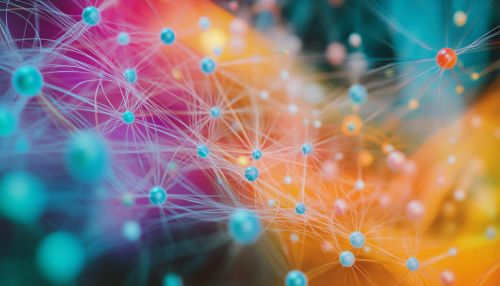Quantum many-body systems: Difference between revisions
(Created page with "== Introduction == Quantum many-body systems are a fundamental area of study in quantum mechanics, focusing on the collective behavior of systems with a large number of interacting particles. These systems are crucial for understanding a wide range of physical phenomena, from the properties of condensed matter to the behavior of nuclear and elementary particles. The complexity of these systems ari...") |
No edit summary |
||
| Line 21: | Line 21: | ||
Tensor network methods are a set of techniques that use tensor algebra to efficiently represent and manipulate quantum states. These methods are particularly useful for studying one-dimensional systems, where they can provide highly accurate results. The [[matrix product state]] and [[projected entangled pair state]] are examples of tensor network states used in the study of quantum many-body systems. | Tensor network methods are a set of techniques that use tensor algebra to efficiently represent and manipulate quantum states. These methods are particularly useful for studying one-dimensional systems, where they can provide highly accurate results. The [[matrix product state]] and [[projected entangled pair state]] are examples of tensor network states used in the study of quantum many-body systems. | ||
[[Image:Detail-98849.jpg|thumb|center|A visually appealing image of a quantum many-body system, showing a complex network of interacting particles in a colorful and dynamic arrangement.|class=only_on_mobile]] | |||
[[Image:Detail-98850.jpg|thumb|center|A visually appealing image of a quantum many-body system, showing a complex network of interacting particles in a colorful and dynamic arrangement.|class=only_on_desktop]] | |||
== Computational Approaches == | == Computational Approaches == | ||
Latest revision as of 20:00, 20 October 2024
Introduction
Quantum many-body systems are a fundamental area of study in quantum mechanics, focusing on the collective behavior of systems with a large number of interacting particles. These systems are crucial for understanding a wide range of physical phenomena, from the properties of condensed matter to the behavior of nuclear and elementary particles. The complexity of these systems arises from the interactions between particles, which can lead to emergent phenomena not present in simpler systems. This article delves into the theoretical frameworks, computational methods, and experimental techniques used to study quantum many-body systems, providing a comprehensive overview of the field.
Theoretical Frameworks
Quantum Field Theory
Quantum field theory (QFT) provides a powerful framework for describing quantum many-body systems. In QFT, particles are treated as excitations of underlying fields, and interactions are mediated by the exchange of virtual particles. This approach is particularly useful for systems where particle number is not conserved, such as in high-energy physics. The Standard Model of particle physics is a prime example of a quantum field theory that describes the fundamental forces and particles in the universe.
Many-Body Perturbation Theory
Many-body perturbation theory is a technique used to approximate the properties of quantum many-body systems. It involves expanding the system's Hamiltonian in terms of a small parameter, typically the interaction strength, and solving the resulting series of equations. This method is particularly useful for weakly interacting systems, where the perturbative expansion converges rapidly. Common techniques include the Hartree-Fock method and density functional theory.
Quantum Monte Carlo Methods
Quantum Monte Carlo (QMC) methods are a class of numerical techniques used to study quantum many-body systems. These methods rely on stochastic sampling to evaluate quantum mechanical observables, making them particularly useful for systems with strong correlations or large numbers of particles. QMC methods include variational Monte Carlo, diffusion Monte Carlo, and path integral Monte Carlo.
Tensor Network Methods
Tensor network methods are a set of techniques that use tensor algebra to efficiently represent and manipulate quantum states. These methods are particularly useful for studying one-dimensional systems, where they can provide highly accurate results. The matrix product state and projected entangled pair state are examples of tensor network states used in the study of quantum many-body systems.


Computational Approaches
Exact Diagonalization
Exact diagonalization is a computational technique used to solve the Schrödinger equation for small quantum many-body systems. By constructing the Hamiltonian matrix and finding its eigenvalues and eigenvectors, researchers can obtain exact solutions for the system's energy levels and wavefunctions. This method is limited by computational resources, as the size of the Hamiltonian matrix grows exponentially with the number of particles.
Density Matrix Renormalization Group
The density matrix renormalization group (DMRG) is a numerical technique used to study low-dimensional quantum many-body systems. It is particularly effective for one-dimensional systems, where it can provide highly accurate results. DMRG works by iteratively optimizing a reduced representation of the system's wavefunction, allowing for the efficient calculation of ground state properties.
Quantum Computing
Quantum computing offers a promising approach to solving problems in quantum many-body physics. By leveraging the principles of quantum mechanics, quantum computers can perform certain calculations exponentially faster than classical computers. Quantum algorithms, such as the quantum phase estimation and variational quantum eigensolver, are being developed to study quantum many-body systems.
Experimental Techniques
Ultracold Atomic Gases
Ultracold atomic gases provide a versatile platform for studying quantum many-body systems. By cooling atoms to near absolute zero temperatures, researchers can create highly controlled environments where quantum effects dominate. Techniques such as optical lattices and Feshbach resonances allow for the precise manipulation of interactions between atoms, enabling the study of phenomena such as Bose-Einstein condensation and superfluidity.
Solid-State Systems
Solid-state systems, such as superconductors and quantum dots, offer another avenue for exploring quantum many-body physics. These systems exhibit a wide range of emergent phenomena, including quantum Hall states and topological insulators. Advances in material science and nanotechnology have enabled the fabrication of novel solid-state systems with tailored properties, providing new opportunities for experimental investigation.
Neutron and X-ray Scattering
Neutron and X-ray scattering techniques are powerful tools for probing the structure and dynamics of quantum many-body systems. By measuring the scattering patterns of neutrons or X-rays as they interact with a material, researchers can gain insights into the arrangement of atoms and the nature of their interactions. These techniques are widely used in the study of crystallography and magnetism.
Applications and Implications
Condensed Matter Physics
Quantum many-body systems are central to the study of condensed matter physics, where they are used to model the behavior of solids and liquids. Understanding the collective behavior of electrons in a solid, for example, is essential for explaining phenomena such as electrical conductivity, magnetism, and superconductivity. Advances in this field have led to the development of new materials with novel properties, such as high-temperature superconductors.
Quantum Information Science
Quantum many-body systems play a crucial role in quantum information science, where they are used to study the fundamental limits of information processing and storage. Concepts such as quantum entanglement and quantum coherence are central to the development of quantum technologies, including quantum computing, quantum cryptography, and quantum teleportation.
Fundamental Physics
The study of quantum many-body systems has profound implications for our understanding of fundamental physics. By exploring the collective behavior of particles, researchers can gain insights into the nature of quantum phase transitions, emergent phenomena, and the unification of forces. These investigations have the potential to shed light on some of the most profound questions in physics, such as the nature of dark matter and the origin of the universe.
Challenges and Future Directions
Complexity and Computation
One of the primary challenges in studying quantum many-body systems is the inherent complexity of these systems. As the number of particles increases, the size of the Hilbert space grows exponentially, making it difficult to perform exact calculations. Advances in computational techniques, such as machine learning and quantum simulation, are being explored to overcome these challenges.
Experimental Realization
Realizing and controlling quantum many-body systems in the laboratory presents significant experimental challenges. Precise control over interactions, temperature, and external fields is required to study these systems, and new techniques are continually being developed to achieve this level of control. The development of quantum simulators and other experimental platforms is expected to drive significant progress in the field.
Interdisciplinary Connections
Quantum many-body systems are inherently interdisciplinary, with connections to fields such as statistical mechanics, quantum chemistry, and biophysics. By fostering collaborations across disciplines, researchers can leverage insights from diverse areas to tackle complex problems and develop new theoretical and experimental approaches.
